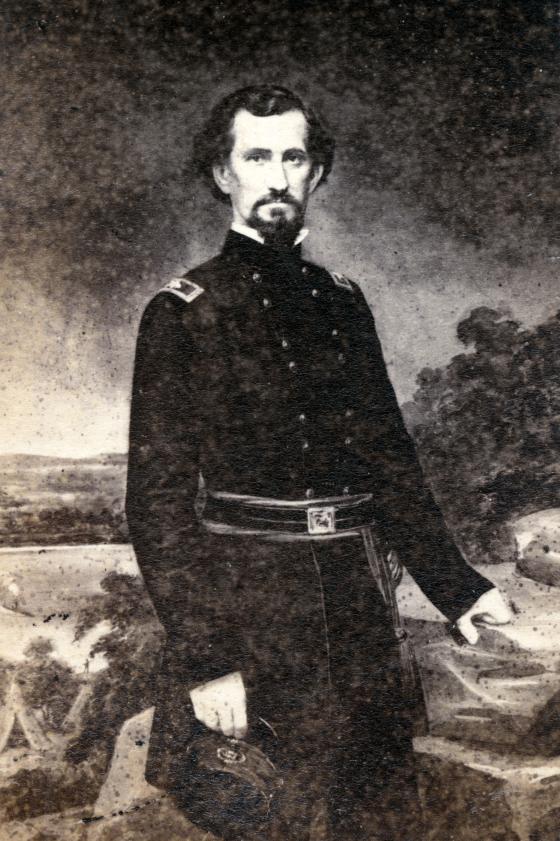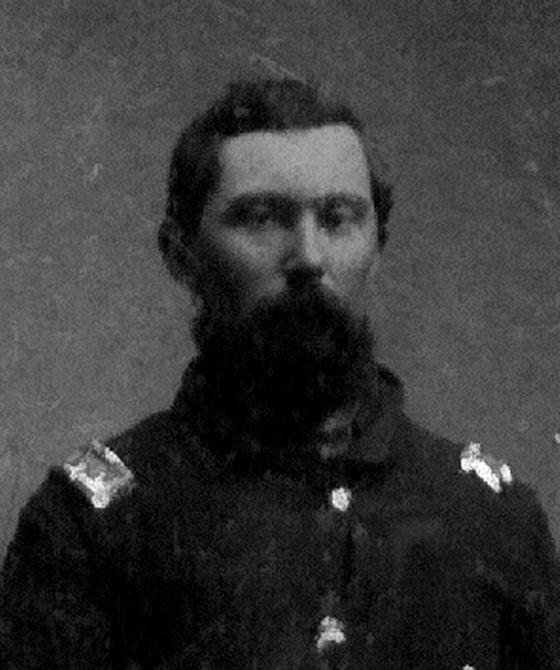The Fight for Cumberland Gap

The Cumberland Gap is located in the heart of the Appalachian mountains and touches three states: Kentucky, Tennessee, and Virginia. During the Civil War, the Gap was vital to both sides, with controlling access into those states and the Virginia and East Tennessee Railroad running a few miles to the south. Because of its importance, both sides fought to maintain this historical gap for almost two years, starting in 1861 and ending in 1863.

On September 14, 1861, Confederates under Gen. Felix Zollicoffer captured the gap and constructed earthworks on the north side for its defense. Soon, Zolliecoffer began using the gap as a springboard for forays into Kentucky. On September 19th, in Knox County, Zollicoffer won a battle at Barbourville. A month later, he was defeated at the Battle of Camp Wildcat, on October 21st, in Laurel County, and was forced back towards the Gap. During the latter parts of 1861, Zolliecoffer moved his forces towards Somerset, Kentucky, leaving a small garrison at Cumberland Gap. After the dramatic Confederate defeat at Mill Springs, Kentucky, Federal forces focused their attention on capturing the Gap.

The Federal capture of Cumberland Gap began in early February when Col. Samuel P. Carter moved his brigade near the Gap but was stopped from making any further movements because of bad weather. By March, Carter was ready to try again; this time, he sent a small force of Federals towards Big Creek Gap (southwest of Cumberland Gap). Carter hoped that the garrison in Cumberland Gap would divert men to combat this threat and thus allow him to take the lightly defended area. On March 21st, Carter left his camp at Cumberland Ford and advanced towards the pass. After marching two miles, Carter was informed that the portion of the garrison that left the Gap had returned. Deciding to camp for the night, Carter laid plans to probe the Gap's defenses the following day. On March 22nd, Carter's force moved out and pushed the Confederates back but found their main lines too strong and decided to pull back his forces to Cumberland Ford. This first offensive against the Gap proved to Carter that the only way to take the Gap was by flanking it to the south from Tennessee.
On March 28, 1862, Gen. Geroge Washington Morgan was placed in command of the newly formed 7th Division of the Army of the Ohio. This division was tasked with taking the Gap and, if possible, moving into East Tennessee. Four brigades were placed under Morgan's command: the now Brig. Gen. Samuel P. Carter (24th), Birg. Gen. James G. Spears (25th). Col. John F. DeCourcy (26th), and Brig. Gen. Absalom Baird (27th), totaling around 10,000 men. After taking command, Morgan sent scouts to the Gap and came to a similar conclusion as Carter. Attacking the heavily fortified gap was impossible from the North, and the only way to take it was from the South. Meanwhile, the Confederates forces guarding the Gap were reorganizing. Gen. Carter L. Stevenson was sent to re-enforce the Gap, resulting in the garrison's force reaching almost 4-5,000 men in three brigades commanded by Col. James E. Rains, Brig. Gen. Seth M. Barton, and Col. Thomas H. Taylor.

On April 28th, Col. DeCourcy's brigade was sent to scout around the Gap and found that Gen. E. Kirby Smith, the Confederate commander for the Department of East Tennessee, was shifting troops up and down the Cumberland mountains to and from Chattanooga. With this information, Gen. Morgan waited till June to make his move on the Gap in coordination with a Federal move towards Chattanooga. He planned to use all four brigades to cross over the Cumberland Mountain, to the south, at two gaps, Rogers and Big Creek Gap. DeCourcy and Baird’s would cross at Rogers Gap. Spears and Carter would cross over Big Creek Gap. The march began on June 6th, with DeCourcy's brigade moving first, then Baird's, Spears's, and Carter's. The march over the Cumberland Mountains was no easy task. Teams in each brigade had to be sent ahead to clear the roads and make them wider for the artillery attached to the division. By June 10-11, most of Morgan's men were across or near the lower gaps. Morgan's progress was temporarily halted when he received conflicting orders from his superior, Gen. Don Carlos Buell, and Chief-of-Staff James B. Fry, telling him to remain cautious and not be risky. However, by the 12th, Morgan received the word he could continue towards Cumberland Gap. With Morgan advancing towards their rear, the Confederates began to fall back from the Gap and retreat towards Tazwell, Tennessee. After a few days of marching, Morgan's command made it to Cumberland Gap on June 18th with Spears's brigade entering first, followed by DeCourcy, Baird, and Carter.
Throughout the summer and early fall of 1862, Morgan worked tirelessly to rebuild Cumberland Gap's defense and prepare for a campaign into East Tennessee. The Confederates, in the meantime, were planning to launch an offensive into Kentucky. In August 1862, Kirby Smith moved his Confederate army, based in Eastern Tennessee, towards Cumberland Gap. Knowing that Morgan had enough supplies for a month and held a completed defensive line, he decided it was best to besiege and starve the Federals out rather than attack them head-on. Smith left Gen. Carter L. Stevenson's division for this duty while Smith's main army moved around Morgan's. Over several weeks, Morgan's men skirmished with Stevenson's command until early September, when things turned bad for the besieged Federals. The division's food supplies started to run low, and word was received that the Union army in Richmond, Kentucky, was defeated, thus cutting off Morgan's line of supplies. On September 14th, Morgan called a council of war, and the party decided that the now 7,000-man division would trek 200 miles through eastern Kentucky rather than surrender and make their way to the Ohio River. On the night of the 17-18, Morgan evacuated the division from the Gap. Morgan's division marched for almost a month, frequently fighting Confederate cavalry under Col. John H. Morgan. Still, by October 3rd, the division made it to the Ohio River at Greensburg, Kentucky. Confederate General Carter L. Stevenson's division occupied the Gap on September 18th and then pressed on toward the heart of Kentucky. Military action at the Cumberland Gap grew quiet until after the Battle of Perryville, Kentucky, when Gen. Braxton Bragg moved his army through the Gap and toward Knoxville, Tennessee.
Besides a Union raid led by Samuel P. Carter in the last week of December, military activity at the Gap remained quiet. Then, in the spring of 1863, things began to change. In March, Union Gen. Ambrose E. Burnside was placed in command of the Department of the Ohio and was tasked with liberating Eastern Tennessee from Confederate control. In the meantime, Confederate command over the Department of East Tennessee was given to Kentuckian Gen. Simon B. Buckner, who set about reorganizing the department. By the summer of 1863, Burnside was hindered in his efforts to take Eastern Tennessee when his beloved 9th Corps, who had accompanied him, was sent to Vicksburg. To weaken Confederate control in Eastern Tennessee, Burnside ordered Brig. Gen. William P. Sanders to take a mounted brigade and destroyed the Virginia and Tennessee raid road that fed into the vital city of Knoxville. In mid-June, Sander, with his 1,000-man brigade, went into the Knoxville area, successfully cutting rail lines and bridges and capturing men and horses.

By the early fall of 1863, Federal forces under William S. Rosecrans captured Chattanooga. Bragg decided to absorb the men under Buckner and join his Army of Tennessee in Northern Georgia. However, before Buckner left for Georgia, he gave Brig. Gen. John W. Frazer command over the Gap and ordered him to defend it at all hazards. Frazers, largely inexperienced 2,400 men, began strengthening the Gap's defenses and waited for further developments. By mid-August 1863, Burnside had regained the 9th corps and launched his campaign into Eastern Tennessee. His force, dubbed the Army of the Ohio, included the 9th and 23rd corps and a cavalry corps. By late August, Burnside's force neared Cumberland Gap. Rather than attacking it, Burnside left a small brigade under the command of Cumberland Gap veteran Col. John F. DeCourcy to guard the Northern approach to the Gap. To deceive the Confederates that his force was much larger than it was, DeCourcy switched the regimental numbers on the soldiers' hats to make it seem as if there were dozens of different regiments and marched them back and forth in clearings that Brig. Gen. Frazer could see making Frazer believe the men to his front were vastly larger.

By September 2nd, Burnside's army captured the undefended city of Knoxville. Upon learning that the Confederate garrison at Cumberland Gap hadn't surrendered, Gen. Burnside sent James M. Shacklford's mounted brigade ahead to secure the southern approaches to the Gap. On September 7th, Shacklford's brigade made it into the area and demanded Frazer surrender the garrison, which Frazer quickly declined. Throughout the night of the 7th and through the 8th, Shackford's force took Frazer's outer line of rifle pits. On the next day, DeCourcy demanded the garrison surrender, which Frazer declined again but this time called a council of war to determine with his officers what to do. Many were divided, but Frazer ultimately decided to hold out. Later that afternoon, DeCourcy's force probed the Southern defenses on the northern side. Finally, on September 9th, Burnside arrived at the Gap with Col. Samuel A. Gilbert's brigade. Frazer, hearing Burnside was in the gap, believed the ruse that the Federal forces in front of him were much larger than they were and decided to surrender that day. In an instant, around 2,000 men, including Frazer, surrendered to the Federal force. However, controversy arose when it was discovered that about 100-300 Confederates escaped through the northern approaches along the Harlan Road and were making their way into southwestern Virginia. Since DeCourcy was ordered to defend this area and failed to stop the 100-300 men, he was arrested, but the matter was dropped. Because of Frazer's surrender, he was branded as a coward in the South and was held in a northern prison for the rest of the war.
After the Federal occupation of Cumberland Gap for the second time, no Confederate force was sent to try and recapture it. Throughout the rest of Burnside's Knoxville Campaign and the Civil War, the gap was primarily used as a way station for supply wagons coming into and out of Eastern Tennessee. Nevertheless, the vital importance of the Cumberland Gap can not be underestimated; without its control, neither side could have controlled Eastern Tennessee or launched raids into Kentucky.
Related Battles
2
2,024


